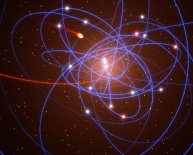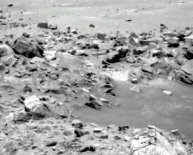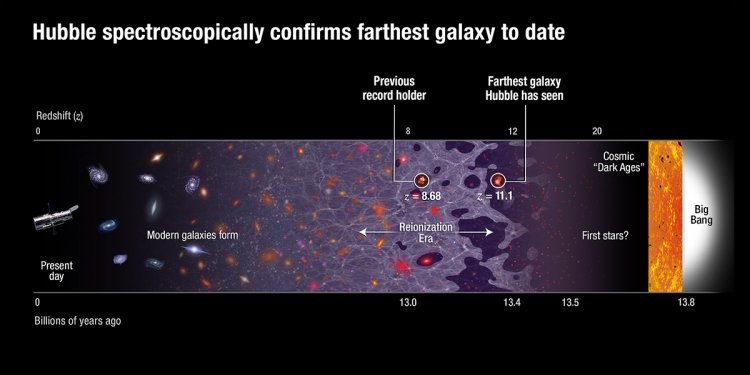
Hubble latest discovery
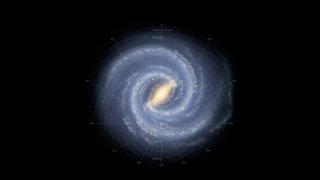 These four Hubble images of Neptune were taken with the Wide Field Camera 3 on June 25-26, 2011, during the planet's 16-hour rotation. The snapshots were taken at roughly four-hour intervals, offering a full view of the planet. The images reveal high-altitude clouds in the northern and southern hemispheres. The clouds are composed of methane ice crystals.
These four Hubble images of Neptune were taken with the Wide Field Camera 3 on June 25-26, 2011, during the planet's 16-hour rotation. The snapshots were taken at roughly four-hour intervals, offering a full view of the planet. The images reveal high-altitude clouds in the northern and southern hemispheres. The clouds are composed of methane ice crystals.
The gas giant planet Neptune takes center stage in a series of sharp new photos snapped by the Hubble Space Telescope in honor of the blue-green world's first Neptunian year around the sun since it was discovered in 1846.
Neptune takes about 165 years to complete one orbit around the sun. It is about 30 times farther from the sun than Earth and typically orbits at a distance of about 2.8 billion miles (4.5 billion kilometers). [Photos of Neptune: Latest Hubble and Voyager Views]
Big, blue Neptune
On June 25, 2011, Neptune arrived at the same location in space where it was discovered 165 years earlier. To commemorate the event, NASA's Hubble Space Telescope took "anniversary pictures" of the blue-green giant planet.
Credit: NASA, ESA, and the Hubble Heritage Team (STScI/AURA)The images were taken about four hours apart and show the planet as it appeared between June 25 and 26 over the course of a single Neptunian day, which lasts about 16 hours, yielding a complete view of the distant world.
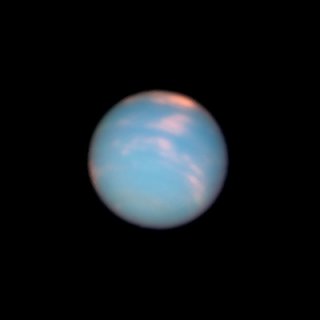 The clouds are composed of methane ice crystals and hover over parts of Neptune's northern and southern hemisphere, Hubble scientists said.
The clouds are composed of methane ice crystals and hover over parts of Neptune's northern and southern hemisphere, Hubble scientists said.
Like Earth, Neptune spins on a tilted axis, which gives the planet its own set of seasons. Earth's axis is tilted about 23 degrees, but Neptune has a more pronounced 29-degree tilt.
While Earth's seasons tend to last a few months each, a single season on Neptune runs for about 40 Earth years, scientists explained. Currently it is early summer in Neptune's southern hemisphere and winter in the north, they added.
The large temperature differences between Neptune's warm interior and its super-chilly cloud tops, which can reach minus 260 degrees Fahrenheit (minus 162 Celsius), may be responsible for large-scale weather changes, Hubble scientists said.
A color image composed of exposures made through three color filters shows the disk of Neptune, revealing clouds in its atmosphere. Forty-eight individual images from a single filter were brightened to reveal the very faint moons and composited with the color image. Triton, in the lower left corner, is the brightest of the moons seen in these images, farthest from the planet, and moves in a counter-clockwise sense in this view.
Credit: NASA, ESA, and the Hubble Heritage Team (STScI/AURA)Discovering the eighth planet
The story of Neptune's discovery in the 19th century is unique among the planets of the solar system. It was the first planet to be discovered using mathematics, with astronomers predicting Neptune's position after observing that the orbit of Uranus — the seventh planet from the sun — did not exactly match up with Newton's theory of gravity.
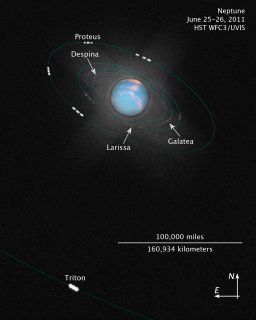 According to NASA, it was the French astronomer Alexis Bouvard in 1821 who first speculated that another planet was tugging on Uranus and tweaking its orbit. By 1841, mathematician-astronomers Urbain Le Verrier of France and John Couch Adams of England had each independently predicted the location of this mystery planet.
According to NASA, it was the French astronomer Alexis Bouvard in 1821 who first speculated that another planet was tugging on Uranus and tweaking its orbit. By 1841, mathematician-astronomers Urbain Le Verrier of France and John Couch Adams of England had each independently predicted the location of this mystery planet.
Le Verrier passed the information on to the man who would actually discover Neptune — German astronomer Johann Gottfried Galle of the Berlin Observatory — and Galle spotted the planet less than a degree from its predicted location during a two-night campaign in September 1846.
"The discovery was hailed as a major success for Newton's theory of gravity and the understanding of the universe, " Hubble scientists said.
Still, while Galle is credited as Neptune's discoverer, he wasn't the first person to actually see the planet.
Neptune's position in the sky is plotted on this star map, along with the 1846 predicted positions of its location, and where it was eventually discovered. The blue planet resides in the constellation Aquarius for the rest of 2011.
Credit: Sky & Telescope 2011In December 1612, the famed astronomer Galileo Galilei recorded an observation of Neptune, which he described as a "star" in his notebook while making observations using a handmade telescope, Hubble officials said. Later, in January 1613, Galileo noticed that the so-called "star" had shifted position in relation to other stars, but he never actually identified the object as a planet or followed up that initial observation.
That leaves the honor of Neptune's discovery securely with Galle.
Neptune is so far away that it cannot be seen with the unaided eye. A small telescope or binoculars can resolve the planet. Currently, Neptune can be found in constellation Aquarius, close to the boundary with Capricorn, Hubble officials said.
You can follow SPACE.com Managing Editor Tariq Malik on Twitter @tariqjmalik. Follow SPACE.com for the latest in space science and exploration news on Twitter @Spacedotcomand on Facebook

